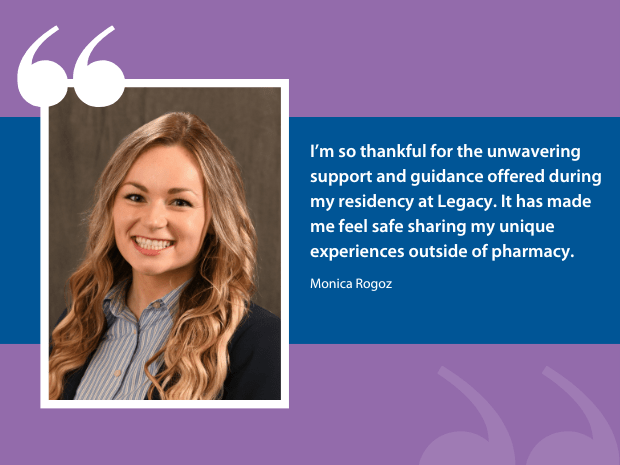The Dance of Pharmacy: Reflections from a Current Pharmacy Resident
May 30, 2023
Home > About > News & Media > Story Center
Outside of pharmacy, my biggest passion in life is dance. The joy of creative expression and the adrenaline rush that comes from performing in front of a crowd – it’s incredible. I grew up doing studio dance (tap, ballet and jazz) followed by high school dance team at Tigard High School. Then the collegiate dance team at both University of Portland and Oregon State University, followed by dancing at the professional level for the Portland Winterhawks ice hockey team for a season. Prior to residency, I shied away from sharing this part of my life with my employers and professional connections. I had a fear of not being taken seriously in my role as a health care professional if people knew that I spent my evenings and weekends in a uniform, with full game day hair and makeup, dancing with pom poms for sports fans during timeouts and halftime.
Upon reflection, however, I recognize the unique value and strengths from my experiences on collegiate and professional dance teams. I’ve identified five principles that I feel are relatable to success both in a pharmacy residency and on dance teams.
Commitment
The standard expectation on a collegiate or professional dance team is to practice outside of allotted practice time. On a dance team, if you want to be successful and know the choreography inside and out, you must put in the work outside of practice time. This includes practicing the choreography on your own, coming to practice early and/or staying late to practice the routines with teammates, and then doing additional workouts outside of dance to maintain your level of fitness. Because of a love and joy for dance, the dedication and time commitment required doesn’t seem overwhelming. Rather, it’s something you truly want to invest time and energy into in order to push yourself to become a better dancer.
In a residency, the same level of commitment applies. Pharmacy residents are expected to put in time, effort and hard work outside of the allotted “9 to 5” business hours to be successful. During residency, if you want to develop into an excellent clinical pharmacist, you need to put in the work outside of scheduled hours to prepare topic discussions, complete drug information questions, look up questions, prepare patient case presentations, prepare journal clubs and complete research and other projects by a set deadline. Dedication to this transition from student to resident to new practitioner is what motivates you to put in those long hours and keep challenging yourself to become a better pharmacist.
Practice
The key to mastering a dance routine is repetition. Practice, practice, practice. The ultimate goal in mastering a dance routine is to achieve muscle memory. In other words, when the music comes on, your body just knows how to move. Instead of feeling nervous and focusing so hard on remembering the choreography, you can now enjoy the routine. Enjoy the music. Enjoy the feeling of performing in front of a crowd. The only way to achieve muscle memory is to practice. Keep practicing. And then, practice some more.
As repetition is the key to mastering a dance routine, so is repetition for mastering a pharmacy residency. Each rotation is like its own unique dance routine: the patient population, disease states, projects and expectations change and develop with every rotation. Over the course of the rotation, you develop and practice your skills with the ultimate goal of feeling competent running the service under the guidance of your preceptor. I feel that this idea of continuously practicing and honing your knowledge and skills grows immensely over the course of residency and continues career-long.
Feedback
On dance team, we frequently practice routines in small groups in front of our teammates and ask for feedback and constructive criticism to improve our performance. Sometimes, you don’t even realize that you're doing a specific dance move wrong or doing it at the wrong time. (In the dance world we describe it as “on the wrong count.”) This process is often eye-opening and there’s a level of mutual respect between teammates during constructive criticism. Our collective goal is to perfect the routine. By performing the routine in front of your coach and teammates and getting feedback, you're able to correct your mistakes and improve your personal performance the next time, which by extension improves the performance of the team.
Similarly, in residency, you are asked to complete frequent evaluations in order to receive (and provide) feedback on performance during clinical rotations, longitudinal staffing and major projects. By receiving frequent feedback, you’re able to implement changes to improve patient care, efficiency and clinical knowledge. Our collective goal is to provide safe and effective patient care, and there’s a similar level of respect for the preceptors and pharmacists providing feedback which serves to propel you forward to improve your skills and become a better pharmacist.
Teamwork
My favorite part about being on a dance team has always been the team itself. Belonging. A support system. A clearly defined role (choreography) for every dancer that comes together beautifully. As a member of a team, you work hard individually, but also support one another. If there’s ever confusion about choreography, we go to our teammates first to clarify the movement. If we can’t reach a consensus, then we go to our coach who will make the final call. From a creative perspective, we’re able to accomplish so much more on a team than we ever could as solo dancers. I also love watching my teammates dance – you learn so much from each dancer’s unique style. It also makes you work hard to maintain a performance that is on par with your teammates.
During residency, I’ve experienced a similar level of exceptional teamwork within Legacy. As a new member of this team, I’ve felt nothing but supported and welcomed. The team is highly collaborative and receptive to questions. Pharmacy team members reach out to me when I’m staffing and offer their support. If a question cannot be answered by a teammate or there is confusion regarding a specific policy or protocol, we reach out to management for the final call, like a dance team would reach out to its coach. Residency at Legacy provides an incredible opportunity to develop professionally among the brightest pharmacist colleagues. I learn so much about various work styles by engaging with various members of the team.
Performance
In dance, it all comes down to the performance. After practicing for hours, you finally perform the routine with your team in front of that crowd. There is such an adrenaline rush that comes from performing in front of a packed stadium and contributing to the entertainment at sporting events. The goal on a dance team is to entertain. Seeing the crowd smile and hearing the applause is incredibly rewarding after all the demanding work that you’ve put into the team and making that dance performance excellent.
In pharmacy, there are many instances of “performances” into which we pour hours of work, preparation and study. Patient case and journal club presentations, recommendations during rounds, answering drug information questions and participating in codes are examples of performances in pharmacy. The goal is high quality, safe patient care. Working hard and putting in those long hours helps you to be as prepared as possible for those pharmacy performances.
I’m so thankful for the unwavering support and guidance offered during my residency at Legacy. It has made me feel safe sharing my unique experiences outside of pharmacy. Although the uniform and skillset may look different, the underlying principles driving a successful pharmacy residency and dance team experience are very much the same.


